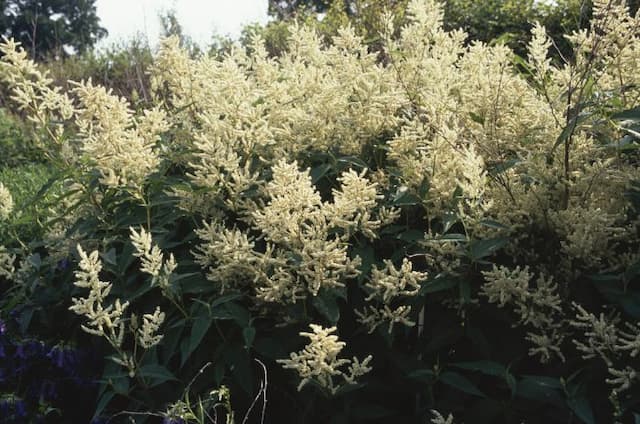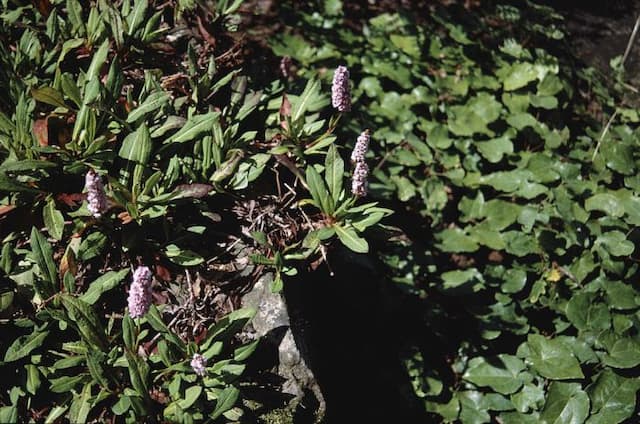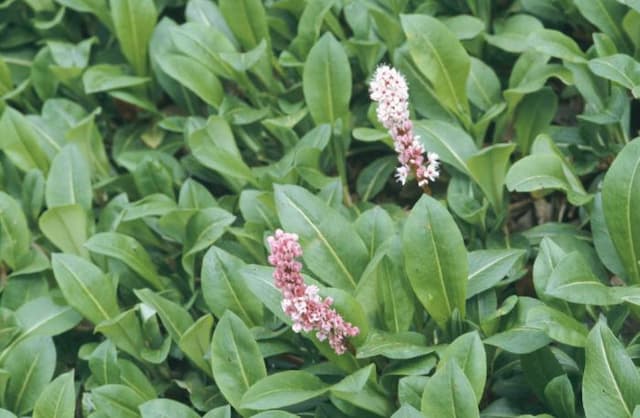Persicaria microcephala 'Red Dragon' (PBR)

ABOUT
The 'Red Dragon' is a visually striking plant that boasts a dramatic range of colors and patterns. Its heart-shaped leaves are a canvas of deep purples, featuring intricate patterning in shades of green, silver, and a wine-red backdrop that seems to ebb and flow across the leaf surface. The foliage often displays a prominent central chevron mark that accentuates its unique appearance. As the seasons change, the leaves may also feature hints of green and bronze, giving a dynamic quality to the plant's overall look. Adding contrast to the colorful foliage, tiny, white, airy flowers emerge, dotting the plant and giving it a delicate appearance despite the boldness of its leaves. As these flowers mature and the season progresses, they can develop a touch of pink, complementing the underlying hues of the foliage. The overall impact of the 'Red Dragon' is a rich tapestry of color and texture, making it a standout in any garden setting. Its exotic appearance is reminiscent of a living painting, with each leaf contributing to a vibrant display that captures the eye and ignites the imagination.
About this plant
 Names
NamesFamily
Polygonaceae
Synonyms
Red Dragon Knotweed, Red Dragon Fleeceflower
Common names
Persicaria microcephala 'Red Dragon' (PBR)
 Toxicity
ToxicityTo humans
Persicaria microcephala 'Red Dragon' is not typically considered a poisonous plant to humans, and there are no widespread reports of toxic reactions upon ingesting this plant. However, it is generally recommended not to consume any part of ornamental plants due to potential individual allergies or digestive irritation.
To pets
Persicaria microcephala 'Red Dragon' is also not known to be toxic to pets. Like with humans, ingestion of ornamental plants is not advised because they may cause stomach upset or an allergic reaction in some pets. If ingestion occurs, monitoring for any signs of distress is prudent, and if symptoms arise, contacting a veterinarian would be the appropriate action.
 Characteristics
CharacteristicsLife cycle
Perennials
Foliage type
Deciduous
Color of leaves
Mixed
Flower color
White
Height
3 feet (0.9 meters)
Spread
2 feet (0.6 meters)
Plant type
Herb
Hardiness zones
5
Native area
China Korea
Benefits
 General Benefits
General Benefits- Ornamental Appeal: Adds striking foliage color with its deep red and purple leaves, making it a visually appealing addition to gardens and landscapes.
- Easy to Grow: Adaptable to a range of soil types and growing conditions, it is a good option for both novice and experienced gardeners.
- Drought Tolerant: Once established, it can survive with minimal watering, making it a valuable plant in areas prone to drought or for water-wise gardens.
- Attracts Wildlife: The flowers can attract pollinators such as bees and butterflies, promoting biodiversity.
- Low Maintenance: Requires minimal pruning and is generally free from major pest and disease problems.
- Fast Growth: Can quickly fill in garden spaces, providing rapid coverage and satisfying quick landscaping results.
- Versatile Use: Suitable for borders, ground cover, and container gardening, making it a flexible choice for various garden designs.
- Seasonal Interest: Offers multi-season appeal with changing leaf colors from spring to fall.
- Non-Invasive: Though it spreads, it is not considered invasive, making it a responsible choice for planting.
- Improves Garden Structure: Can be used to create interesting garden structures such as hedges or as a backdrop for other plants.
 Medical Properties
Medical PropertiesThis plant is not used for medical purposes.
 Air-purifying Qualities
Air-purifying QualitiesThis plant is not specifically known for air purifying qualities.
 Other Uses
Other Uses- Fabric Dye: 'Red Dragon' can be used to produce natural dyes for textiles, with parts of the plant lending a unique hue to the fabric.
- Ink Production: The plant can be processed to create a natural ink for art or writing, giving a distinctive color derived from its foliage.
- Educational Tool: 'Red Dragon' is an interesting specimen for botany classes to study plant morphology due to its distinctive foliage and growth patterns.
- Crafts: Dried leaves and stems of 'Red Dragon' can be incorporated into decorative crafts, such as wreaths or dried flower arrangements.
- Photography Subject: With its striking appearance, the plant is a popular subject for garden photographers and plant enthusiasts.
- Biological Pest Control: The plant can be included in a garden setting as part of an integrated pest management program to attract beneficial insects that predate on garden pests.
- Theme Gardens: 'Red Dragon' can be used in thematic garden designs, such as a dragon-themed or fantasy-inspired garden, due to its evocative common name and appearance.
- Culinary Garnish: Although not widely recognized as an edible, the striking foliage can be used as an ornamental garnish for specialty dishes after ensuring it is safe and non-toxic.
- Erosion Control: This robust grower can be used on slopes or areas prone to erosion to help stabilize soil with its root system.
- Mood Setting: Placed in a room or outdoor sitting area, 'Red Dragon' can contribute to creating a specific ambiance or aesthetic, such as a tranquil Asian-inspired garden.
Interesting Facts
 Feng Shui
Feng ShuiThe plant Persicaria is not used in Feng Shui practice.
 Zodiac Sign Compitability
Zodiac Sign CompitabilityThe plant Persicaria is not used in astrology practice.
 Plant Symbolism
Plant Symbolism- Transformation - The 'Red Dragon' variety of Persicaria microcephala often symbolizes transformation due to its dramatic color changes as the foliage evolves through the seasons.
- Energy - The vibrant reddish-purple leaves with their striking patterns suggest a sense of vitality and energy, making this plant emblematic of dynamic life forces.
- Boldness - The intense colors of this plant can be associated with courage and strength, as it stands out prominently in garden settings.
- Passion - Red being a color of passion and emotion, the 'Red Dragon' persona of this plant can be linked to deep feelings and ardent expressions.
 Water
WaterRed Dragon Knotweed prefers consistently moist soil, but it should not be waterlogged. In general, watering once a week with about 1-1.5 gallons of water should suffice, depending on your local climate and soil drainage. During the hot summer months or in particularly dry conditions, you may need to water more frequently, such as every few days. It's important to check the top inch of soil before watering; if it feels dry, it's time to water. During the winter, reduce the frequency of watering as the plant's growth slows down.
 Light
LightRed Dragon Knotweed thrives in a location with full sun to partial shade. It enjoys bright, indirect sunlight and can tolerate direct sun in cooler climates but in hot areas, some afternoon shade is beneficial to prevent leaf scorch. The optimal spot for this plant would be one where it receives morning sunlight and some dappled shade during the hottest part of the day.
 Temperature
TemperatureRed Dragon Knotweed is hardy in temperatures ranging from 0 to 85 degrees Fahrenheit. It can survive minor dips below freezing, but extended exposure to temperatures below 0 degrees can be harmful to the plant. Ideal temperatures for promoting growth are typically between 50 and 70 degrees Fahrenheit, so it's best to plant it in a spot that avoids the extremes of heat and cold.
 Pruning
PruningPruning Red Dragon Knotweed helps maintain its shape, encourages new growth, and can prevent overcrowding. It should be pruned in the late winter or early spring before new growth begins. Pruning can be done annually to remove dead or damaged stems and to shape the plant. Cut back the foliage to promote a fuller plant with more vigorous growth during the next season.
 Cleaning
CleaningAs needed
 Soil
SoilRed Dragon Knotweed thrives in fertile, moist, well-drained soil with a slightly acidic to neutral pH of 5.5 to 7.0. Best soil mix would be equal parts of loam, peat, and sharp sand to ensure good drainage and fertility.
 Repotting
RepottingRed Dragon Knotweed does not typically require frequent repotting. It should be repotted every 2-3 years to prevent root crowding and replenish nutrients.
 Humidity & Misting
Humidity & MistingRed Dragon Knotweed prefers moderate humidity levels but is adaptable to various conditions provided it is well-watered and not waterlogged.
 Suitable locations
Suitable locationsIndoor
Place in bright indirect light with ample airflow.
Outdoor
Full sun to part shade in moist, well-drained soil.
Hardiness zone
5-9 USDA
 Life cycle
Life cycleThe life cycle of 'Red Dragon' Knotweed (Persicaria microcephala 'Red Dragon') begins with seed germination in the spring, requiring consistent moisture and warm temperatures to initiate. Once the seeds have sprouted, the plant enters its growth phase, rapidly developing a robust root system and foliage characterized by its distinctive burgundy leaves with a chevron pattern. Throughout the summer, the plant matures and produces small, inconspicuous flowers which can lead to seed production, although this plant can also spread vegetatively through rhizomes. As autumn approaches, its growth slows down, and in winter, it becomes dormant, with the above-ground parts dying back in colder climates. In spring, new growth emerges from the rhizomes or surviving rootstock, completing the cycle. 'Red Dragon' Knotweed is a perennial, so this cycle repeats annually with the plant continuing to expand in size and spread over the years.
 Propogation
PropogationPropogation time
Spring to Summer
Persicaria microcephala 'Red Dragon', commonly known as Red Dragon Fleeceflower, is best propagated through division, which is the most popular method for this perennial plant. The preferred time for division is during the early spring or fall when the plant is not in active growth. To propagate by division, carefully dig up the plant and use a sharp spade or knife to separate the crown and root system into several sections, ensuring that each section has a portion of the root system and several shoots. Replant the divisions at the same depth they were growing previously, spacing them about 18 inches (approximately 45 centimeters) apart to allow for growth. Water the new divisions well after planting to help establish them. Regular watering will be required until the plants are fully established and showing new growth.

![Red bistort [JS Seven Oaks Village]](/_next/image?url=https%3A%2F%2Fplants-admin.emdemapps.com%2Fimages%2Fplants%2F%2Fimages%2F604b56557c0e3.png&w=640&q=75)







